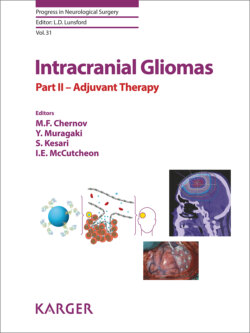Читать книгу Intracranial Gliomas Part II - Adjuvant Therapy - Группа авторов - Страница 9
Preface
ОглавлениеWith this, the second of three consecutive volumes of Progress in Neurological Surgery devoted to current management of intracranial gliomas, we present to the medical community Part II, dedicated to postoperative adjuvant therapy. Such treatment is frequently required after primary resection or at the time of progression of brain tumor, especially one of high grade. Significant progress in our understanding of tumor biology, technological advances in delivery of radiotherapy, and development of novel antitumor agents have led to prominent expansion of the therapeutic arsenal in neuro-oncology. Cell lineage-oriented classification of gliomas no longer appears to satisfy the pathological and clinical needs, and profiling of the major molecular abnormalities in the neoplasm is significantly used to support decision-making on the optimal treatment strategy for attainment of the best possible outcome.
In the opening chapter Komori et al. present contemporary concepts of histopathological typing and grading of gliomas, and highlight the updated World Health Organization classification of tumors of the central nervous system (2016). This new classification scheme considers not only phenotype, but also specific genetic characteristics allowing clinicians to predict prognosis and determine proper treatment. The comprehensive reviews that follow highlight the basic principles and clinical results of therapeutic irradiation of both low- and high-grade gliomas by means of fractionated radiotherapy (by Ghia), stereotactic radiosurgery (by Niranjan et al. and Ganz), and brachytherapy (by Nachbichler and Kreth). Irradiation of brain tumors in pediatric patients requires specific approaches and techniques, which are discussed by Kortmann et al. There is active investigation into radiosensitizers, which may potentially enhance the cytotoxic effects of radiotherapy, and current advances in this field are presented by Cohen and Mehta. Subsequent chapters describe contemporary concepts of chemotherapy for high-grade astrocytomas (by Puduvalli and Hoang), diffuse astrocytoma (by Narita), oligodendrogliomas (by Drappatz and Lieberman), and pediatric brain tumors (by Terashima). Soffietti et al. discuss perspectives of personalized chemotherapy based on the individual molecular characteristics of the neoplasm. Results of antiangiogenic therapy in patients with high-grade gliomas are presented by Jo and Wen. Hu and Kesari share their opinion on the further development of chemotherapeutic strategies in neuro-oncology, and emphasize the importance of the evolving concepts of “targeted therapy” and “personalized medicine.” The emerging therapeutic role of physical and psychological rehabilitation in patients with intracranial glioma is discussed by Andrejeva and Volkova. Finally, Pace and Villani describe nuances of supportive care at the end of life.
Therefore, this publication provides a unique review of the various options for adjuvant therapy of intracranial gliomas and strongly suggests that the most effective treatment strategy must be tailored for each individual patient in order to attain the best possible outcome. Special emphasis is put on current evidence-based treatment standards and guidelines, and on the prospect of further improvement in long-term results.
Our thanks, first and foremost, go to the many contributors to this volume who agreed to share their knowledge and clinical experience, and who dedicated their time to preparing the manuscripts; and to the team at Karger Publishers who provided superb organizational assistance throughout the realization of this publication project. While preparing the book for publication we have tried to be comprehensive and succinct in our review of the literature to make it useful for (and accessible to) all types of readers. We hope the materials presented herein and in the two accompanying volumes of Progress in Neurological Surgery (Intracranial Gliomas Part I – Surgery and Part III – Innovative Treatment Modalities) will carry practical and scientific interest for neurosurgeons, radiation oncologists, neuro-oncologists and other clinicians treating patients with brain tumors.
Mikhail F. Chernov, MD, DMedSci, Tokyo
Yoshihiro Muragaki, MD, PhD, Tokyo
Santosh Kesari, MD, PhD, FANA, FAAN, Santa Monica, CA
Ian E. McCutcheon, MD, CM, FRCS(C), FACS, Houston, TX
